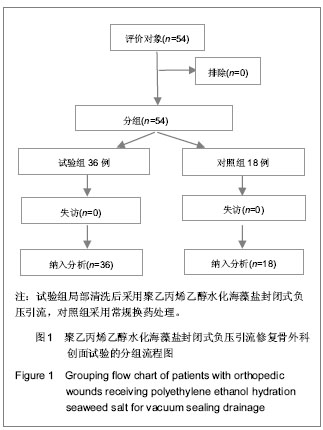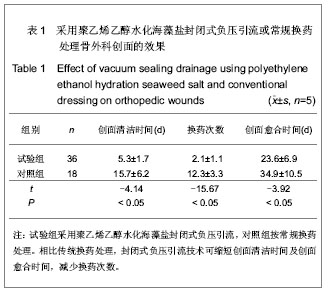| [1] 王新江,马文龙,杜志军,等.VSD结合游离植皮治疗儿童下肢大面积皮肤缺损[J].组织工程与重建外科杂志,2013,9(1):35-36.
[2] 韩家宏,雷楚林,李仁鹏.负压封闭引流技术在下肢大面积皮肤缺损合并感染的应用[J]. 中国烧伤创疡杂志,2010,22(6):445-447.
[3] 王玉良,吴瑞瑜,程璐飞,等.VSD在下肢皮肤缺损及溃疡治疗中的应用[J].基层医学论坛,2012,16(13):1700-1701.
[4] 刘三风,刘志豪,戴志波.负压封闭引流技术(VSD)对各种复杂创面修复的临床研究[J]. 当代医学,2009,15(6):66-68.
[5] 刘洪达,曲家富,李绍光,等.一期解剖复位内固定结合负压封闭引流技术治疗开放性跖跗关节骨折脱位[J].中国骨与关节损伤杂志,2010,25(12):1083-1085.
[6] 曲家富,闫荣亮,王良,等.负压封闭引流技术结合肌瓣转移游离植皮治疗小腿及足踝部软组织缺损伴骨外露[J].中华创伤骨科杂志, 2013,15(4):316-319.
[7] 蒋国群,胡永才,周海洋,等.负压封闭引流技术辅助下游离植皮修复骶尾部压疮疗效观察[J].现代医药卫生,2013,29(12): 1861-1862.
[8] 周杰,黄金华,徐刚,等.游离植皮结合负压封闭引流技术治疗糖尿病足溃疡疗效研究[J].中国全科医学,2010,13(23):2546-2547.
[9] Miller Q, Bird E, Bird K. Effect of subatmospheric pressure on the acute healing wound.Curr Surg.2004;61(2):205-2081
[10] Neumaier J.Innovative therapeutic measures in problem wounds. Autologous skin and vacuum sealing.MMW Fortschr Med.2004;146(17):14.
[11] Abbott CA,Garrow AP,Carrington AL. Foot ulcer risk is lower in South-Asian and African-Caribbean compared with European diabetic patients in the UK:the north-west diabetes foot care study.Diabetes Care.2005;28(8):1869-1875.
[12] 夏远军,章莹,吴文,等.负压封闭引流与常规敷料加压包扎治疗大面积皮肤撕脱伤的疗效对比研究[J].中国骨科临床与基础研究杂志,2011,3(2):97-100.
[13] Furlanetti LL,de Oliveira RS,Santos MV. Multiple cranial burr holes as an alternative treatment for total scalp avulsion. Child's Nervous System.2010; 26(6):745-749.
[14] 张一,田晓滨,韩伟,等.负压封闭引流技术在四肢开放性骨折并皮肤软组织缺损中的应用[J].贵州医药,2008,32(12):1086-1088.
[15] 陈林.负压封闭引流技术在四肢开放性骨折并皮肤软组织缺损中的应用[J].临床医学,2010,30(8):27-28.
[16] Fleischmann W,Strecker W,Bombelli M,et al.Vacuum Sealing as Treatment of Soft Tissue Damage in Open Fractures. Unfallchirurg.1993;96(9):488-492.
[17] 裘华德.负压封闭引流技术[M].北京:人民卫生出版社,2003: 32-82.
[18] Herscovici D Jr,Sanders RW,Scaduto JM,et al. Vacuum-assisted wound closure (VAC therapy) for the management of patients with high-energy soft tissue injuries.J Orthop Trauma.2003;17(10):683-688.
[19] 阿玛德,余国荣,陶圣祥,等.封闭式负压引流治疗下肢大面积软组织缺损的临床观察[J].医学新知杂志,2005,15(2):45-46.
[20] 刘合振,余国荣,周梅君,等.负压封闭引流技术在下肢巨大新鲜创面的应用[J].临床外科杂志,2001,9(4):246-247.
[21] 许诺,袁同洲,王国栋,等.创面封闭式负压引流(VSD)治疗皮肤撕脱伤的体会[J]. 生物骨科材料与临床研究,2009,6(1):41-43.
[22] 郭佳莹,黄萍,曹文凤.负压封闭引流治疗四肢软组织创面的研究进展[J].国际医药卫生导报,2006,12(20):107.
[23] 曹大勇,陈绍宗,汤苏阳,等.封闭式负压引流技术对人慢性创面血管生成的影响[J].中国临床康复,2004,8(2):264-265.
[24] 李靖,陈绍宗,许龙顺.封闭负压引流技术对兔耳创面毛细血管密度及创面愈合的影响[J].中国临床康复,2004,8(5):904-905.
[25] Kilpadi DV,Bower CE,Reade CC,et al.Effect of vacuum assisted closure therapy on early systemic cytokine levels in a swine model.Wound Repair and Regerneration.2006;14(2): 210-215.
[26] 王昌建,姚元章.负压封闭引流治疗肢体远端慢性感染及溃疡创面[J].创伤外科杂志,2005,7(4): 306. |





